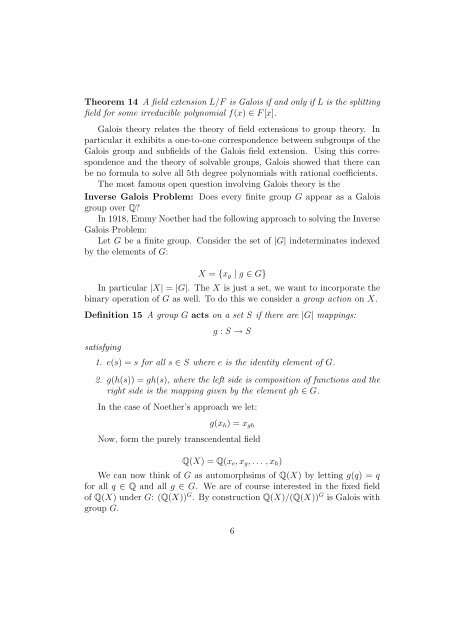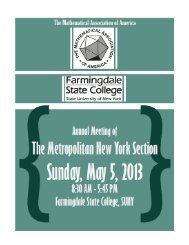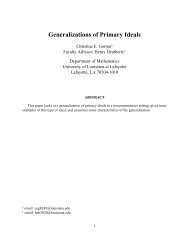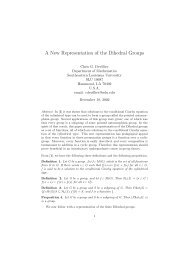Galois Theory and Noether's Problem Meredith Blue ... - MAA Sections
Galois Theory and Noether's Problem Meredith Blue ... - MAA Sections
Galois Theory and Noether's Problem Meredith Blue ... - MAA Sections
You also want an ePaper? Increase the reach of your titles
YUMPU automatically turns print PDFs into web optimized ePapers that Google loves.
Theorem 14 A field extension L/F is <strong>Galois</strong> if <strong>and</strong> only if L is the splittingfield for some irreducible polynomial f(x) ∈ F [x].<strong>Galois</strong> theory relates the theory of field extensions to group theory. Inparticular it exhibits a one-to-one correspondence between subgroups of the<strong>Galois</strong> group <strong>and</strong> subfields of the <strong>Galois</strong> field extension. Using this correspondence<strong>and</strong> the theory of solvable groups, <strong>Galois</strong> showed that there canbe no formula to solve all 5th degree polynomials with rational coefficients.The most famous open question involving <strong>Galois</strong> theory is theInverse <strong>Galois</strong> <strong>Problem</strong>: Does every finite group G appear as a <strong>Galois</strong>group over Q?In 1918, Emmy Noether had the following approach to solving the Inverse<strong>Galois</strong> <strong>Problem</strong>:Let G be a finite group. Consider the set of |G| indeterminates indexedby the elements of G:X = {x g | g ∈ G}In particular |X| = |G|. The X is just a set, we want to incorporate thebinary operation of G as well. To do this we consider a group action on X.Definition 15 A group G acts on a set S if there are |G| mappings:satisfyingg : S → S1. e(s) = s for all s ∈ S where e is the identity element of G.2. g(h(s)) = gh(s), where the left side is composition of functions <strong>and</strong> theright side is the mapping given by the element gh ∈ G.In the case of Noether’s approach we let:g(x h ) = x ghNow, form the purely transcendental fieldQ(X) = Q(x e , x g , . . . , x h )We can now think of G as automorphsims of Q(X) by letting g(q) = qfor all q ∈ Q <strong>and</strong> all g ∈ G. We are of course interested in the fixed fieldof Q(X) under G: (Q(X)) G . By construction Q(X)/(Q(X)) G is <strong>Galois</strong> withgroup G.6
















